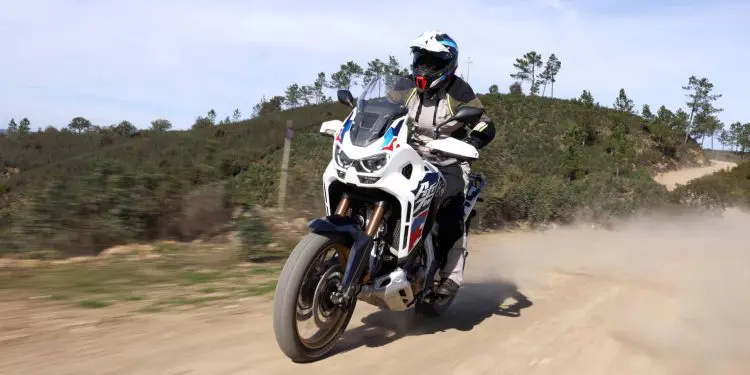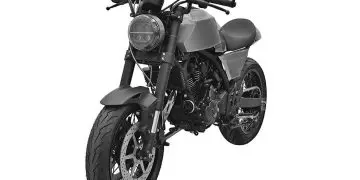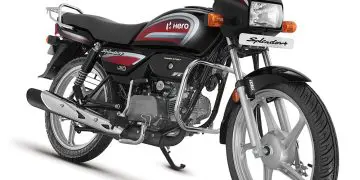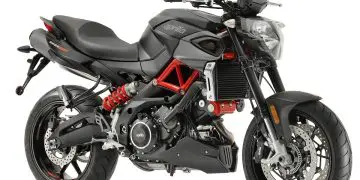Wanting to improve its travel capabilities, the Africa Twin Adventure Sports received important updates for this year: the most talked about has been the installation of a 19-inch front wheel, but the engine also received improvements that increased torque and overall comfort also improved. An Adventure Sports with a now more refined dynamics and that is more comfortable and even easier to ride, in true Honda fashion!
The history of the Africa Twin began in 1986 with the NXR 750, a motorcycle that won the Dakar Rally 4 times, and with which riders, from 1988, could curiously choose a 21” or 19-inch front wheel, depending on the terrain. And it was this model that inspired the creation of the XRV 650 Africa Twin in 1988, which later increased in displacement to 750 cc and was in production until 2001, after selling more than 73,000 units. In 2016 the Africa Twin returned, completely modernized, and shortly after the Adventure Sports version was created, with tweaks made to the various versions up to now. Now, for 2024, Honda presents two versions of the Africa Twin: the base version (which we will test soon), with a 21” front wheel and optional electronic suspensions; and this Adventure Sports version that, without neglecting off-road, presents more road-oriented characteristics through the 19-inch front wheel, standard electronic suspensions, lower seat, among other features.
SOME CURIOSITIES
Since 2021, the Adventure Sports version has already sold globally more than half of the Africa Twin models (about 55%), a model family that has been almost always the best-selling in the Honda range since 2016, with over 100,000 units registered in Europe since 2016. And speaking of numbers, among all Africa Twin sold, the DCT version continues to be the favorite, with about 63% of Adventure Sports sales in the case of 2023.
WHAT HAS CHANGED
In terms of the engine, the 1,084 cc parallel twin still delivers the same 75kW of power (about 102 hp) at 7,500 rpm, but the maximum torque has increased to 112 Nm at 5,500 rpm, an improvement of 7% from low revs that is mainly due to the new internal engine components and the increased compression ratio. We are talking about a redesigned crankshaft and connecting rods, as well as pistons with a slightly altered surface and larger diameter air intake ducts. With the improved fuel injection system and a lighter and more efficient exhaust system, all of this has contributed to better response in the mid-range, without any changes in displacement or the engine’s bore-to-stroke ratio.
A instrumentação mantém-se inalterada, sendo muito completa mas também algo confusa para aceder a algumas informações.
Andámos em versões com e sem DCT. O sistema de transmissão de dupla embraiagem foi ligeiramente melhorado nesta geração.
The driver’s seat has been changed. It is more comfortable and also lower, while the passenger’s seat is also spacious.
High-quality electronic suspensions, good brakes, and now a 19” wheel at the front, which on asphalt brought benefits to the dynamics.
In terms of aesthetics, in addition to the new decorations, it must be said that the front section is slightly different, for better aerodynamics, notably with a side opening next to the headlights that aims to divert air from the driver’s arms and shoulders on the highway. And here it must be said that the windshield, adjustable by hand, is made of a new material (Durabio), and that, although similar in appearance, according to Honda it is much more resistant, moldable, and with excellent characteristics to withstand wear.
OTHER FEATURES
Not being new, it is worth mentioning that the instrumentation continues to be composed of a 6.5” color TFT, with various backgrounds to choose from and connectivity with Apple CarPlay and Android Auto compatible. And all electronic aids are still present in the current model, so we are talking about ABS in curve, adjustable traction control in 7 positions, wheelie control, cruise control, curve lighting, emergency lights when braking, and turn signals with auto-canceling. Regarding the driving modes, there are also no changes, with the usual Tour, Urban, Gravel, and Off-road, plus two User modes, with all safety parameters being controlled by the Bosch 6-axis IMU. And of course, there are no changes in terms of braking, through a proven Nissin set. Before we move on to the dynamic part, it is worth mentioning that there are 4 accessory packages available, Travel, Urban, Adventure, and Rally, so there are components to suit everyone’s taste, whether to show off a more beautiful Adventure Sports at the cafe or to go around the world, if that is the goal!ON THE ROAD
This presentation started off very well in one aspect: it was held in Portugal, in the Algarve, so there was no need to travel by plane! The base was set up in an excellent hotel unit near Albufeira, and during a day we covered nearly 200 km with a lot of mountain roads, some city, some off-road, and a stretch on the highway just to “clean the carbon” and enjoy the aerodynamic protection. The weather was good, and the changes in the chassis and ergonomics were noticed even before we started. We still feel like we are in control of a great trail but it is easy to put our feet on the ground. The driving position is naturally excellent and everything is easy, in the good Honda way, except for everything involving controls and instrumentation… There are too many buttons and too many steps that we have to follow to get to something more specific in the menu, and if a future owner after a few days – or weeks – may be familiar with these controls and TFT, for us journalists who are constantly switching motorcycles, we understand how confusing this system is and far from being one of the most intuitive on the market.GLUED TO THE GROUND
Still on the slow journey around Albufeira, I can say that I didn’t notice any improvements in the functioning of the DCT. It continues to do its excellent job, but I didn’t notice it being smoother when starting off or in those indecisions between gear shifts, nor did I notice any difference in its performance in terms of detecting curves on mountain roads. These are certainly slight improvements that will make the system better and that a long-term driver can enjoy more. What is immediately noticeable is how the 19-inch front wheel helps with the dynamics of the Adventure Sports, especially if the pace is fast and the road surface is good. Of course, the old familiar Africa Twin, with a 21” wheel, always cornered well and gave us confidence, but here we can have a better “feeling”, a greater sense of security as if we understand everything we are stepping on. In fact, during the lunch break, we had the opportunity to ride the previous model and we felt the same way. The new bike is faster and more agile to move between corners, with a better feel of the road, as if we have (and we actually do) more rubber available for grip in corners. Equally noticeable are the improvements in the engine performance at low and medium revs, now the twin-cylinder is much less lazy around 4,000/5,000 rpm, for more fun in driving and easier overtaking, for example.The seat doesn’t feel soft to the touch, but we ended the day the same way we started, without any kind of fatigue, and if we chose to drive on the road with the windshield in the lowest position, on the highway we raised it almost to the top and the protection seemed very good to us. In the highest position, it is at eye level for me (I am about 1.68m tall), so I preferred to lower it slightly. And here is another detail, because this screen is manually adjustable but on both sides, making it difficult to adjust while driving. A central adjustment, for single-handed use, would be ideal. EVERYTHING EASY AND PLEASANTElectronic suspensions are undoubtedly a strong point of this model and we didn’t even need to make adjustments for them to adapt best to our driving style and the route. With the Tour mode activated, which we used most of the time, and with the preload set for a rider without luggage, the suspensions showed excellent tuning, both on smooth surfaces and when the rough terrain could make things more complicated. In an off-road section, we felt the same comfort with the suspensions, but off-road, if the conditions are a bit more challenging, don’t forget that you may need to enter the menus and disable some of the electronics so that the Africa Twin can evolve without issues. In the afternoon, on the way back to the hotel, we rode an Adventure Sports with a manual gearbox, which seemed strange to us, as we hadn’t ridden an Africa Twin with a conventional gearbox for a long time. Personally, like most buyers, I prefer the dual-clutch version for being more practical and still allowing for quick driving (using the paddles if you don’t trust the system’s intelligence), but I understand that many prefer the conventional gearbox, especially those who use it more intensively off-road.
An Africa Twin Adventure Sports that continues to offer everything necessary for a very pleasant and versatile use, in daily life or on trips, on the road or on dirt paths. Now it comes with a more “full” engine and even more refined dynamics on asphalt (besides being easier to ride for those with shorter legs), so the changes made by Honda were once again successful!
HONDA CRF1100L Africa Twin Adventure Sports
Parallel twin-cylinder engine, 8 valves, liquid cooling
DISPLACEMENT 1,084 cc
POWER 75 Kw (102 hp) @7,500 rpm
TORQUE 112 Nm @5,500 rpm
GEARBOX 6 speeds / DCT
FRAME steel tubular
FUEL TANK 24.8 liters
FRONT SUSPENSION Showa EERA inverted telescopic fork, 45 mm, electronic operation, 210 mm travel
REAR SUSPENSION Showa EERA monoshock, electronic operation, 200 mm travel
FRONT BRAKE 2 discs of 310 mm, 4-piston radial calipers
REAR BRAKE 256 mm disc, 2-piston caliper
FRONT TIRE 110/80-R19
REAR TIRE 150/70-R18
WHEELBASE 1,570 mm
SEAT HEIGHT 835-855 mm
PESO 243 kg / 253 kg (DCT)
P.V.P. (desde) 19.240 € / 20.365 € (DCT)








